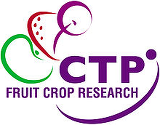After completing a BSc in Biological Science at the University of Exeter, I worked for five years in fundraising for a health charity. In 2017 I completed a masters in applied plant science at the University of Greenwich, graduating with distinction. During my masters, I undertook a research project at NIAB EMR within the genetics departments looking at the diversity of Pseudomonas, a bacterial pathogen and causal agent of canker on Cherry. During this project, I visited growers across the England and Scotland gaining valuable experience of the cherry industry as well as learning key microbiology and genetic techniques within the lab.
agent of canker on Cherry. During this project, I visited growers across the England and Scotland gaining valuable experience of the cherry industry as well as learning key microbiology and genetic techniques within the lab.
Brown Rot, caused by Monilinia spp. is one of the most important diseases in stone fruits worldwide. The primary source of inoculum is from overwintering on mummified fruits left on the trees and the orchard floor. Current control methods include spraying of fungicide. However, the continuing pressure to reduce the uses of these chemicals has seen an increase in research into new control methods, such as biological control methods. NIAB EMR recently identified two microbes that significantly reduced sporulation of M. laxa under laboratory conditions. These two isolates were a bacterial species Bacillus subtilis (B91) and yeast-like fungus Aureobasidium pullulans (Y126), and currently being formulated into commercial products. This project will investigate how to optimise the use of biocontrol products in practice, regarding suppressing sporulation on overwintered mummies and preventing infection of blossoms and fruit. In addition to quantifying the control efficacy, we are also studying the ecology of biocontrol organisms, particularly their survival in commercial orchards. This research will help assist in the development of management strategies for brown rot on stone fruit, integrating BCAs with other management practices based on our understanding of ecological characteristics of available BCAs.
